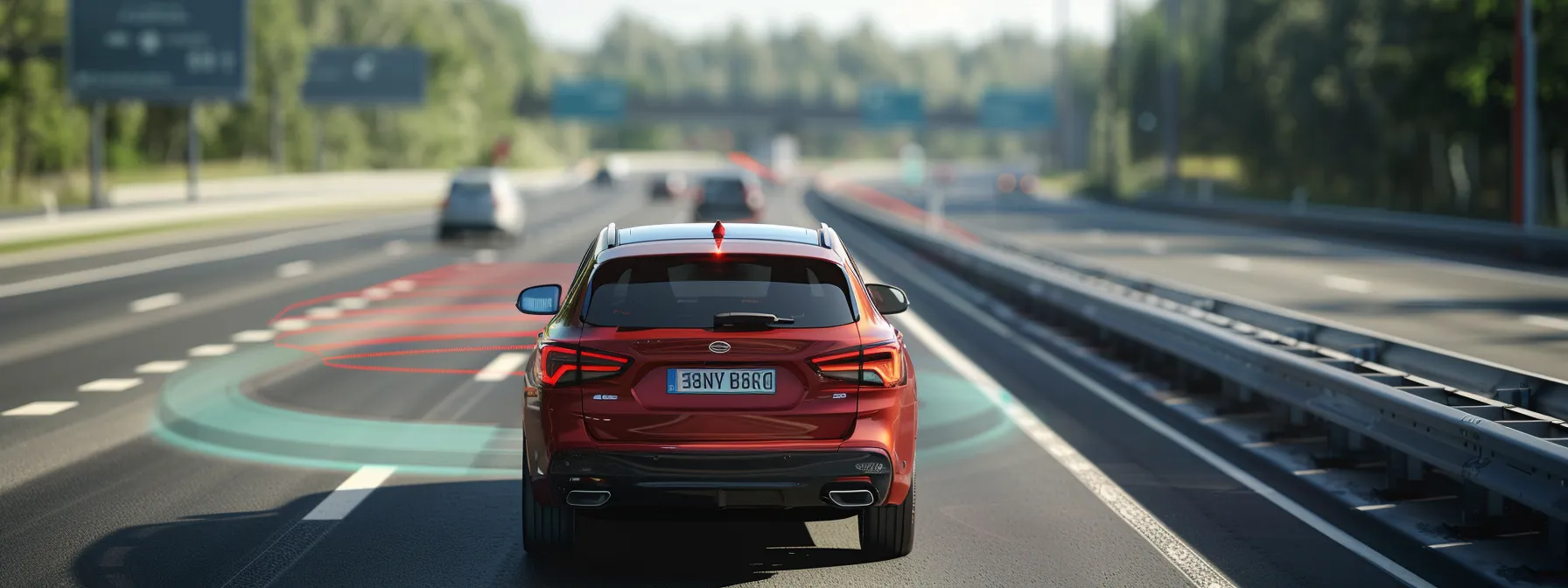Every year, millions find themselves grappling with the aftermath of auto collision, a distressingly common occurrence on today’s roads. This content delves into pivotal strategies to avoid such incidents, with a particular emphasis on understanding common causes, maintaining safe driving distances, and practicing defensive driving. It pinpoints key techniques, from utilizing proper vehicle lighting for enhanced visibility to preparing for diverse weather conditions, equipping the reader with actionable advice for safer navigation. Those seeking to minimize risks on their daily commute will find this guidance not only instrumental in enhancing their driving experience but also crucial in safeguarding their well-being and potentially avoiding costly repairs and medical expenses.
Key Takeaways
- Defensive driving and situational awareness significantly reduce roadway risks
- Proper vehicle preparation and maintenance are crucial for safe driving in adverse conditions
- Managing distractions before driving helps maintain focus and prevent accidents
- Following traffic laws and road signs is fundamental to preventing automobile accidents
- Adjusting speed and following distance according to weather conditions aids in collision prevention
Understanding the Most Common Causes of Auto Collision Today

As the National Highway Traffic Safety Administration (NHTSA) reports, understanding the principal factors in road mishaps is essential in avoiding them. Speeding escalates the prospects of collisions, just as driving under the influence raises the likelihood of a wrongful death claim. Insight into how fatigue impairs driver performance can prevent dangerous errors that lead to vehicle rollovers. Furthermore, recognizing the perils of reckless maneuvers is critical, as these can result in severe damage to the auto body and put one’s safety at risk. This section delves into these key causes, offering practical strategies to mitigate their effect and preserve bone and bodily integrity. If you require Personal Injury Services, Contact Heil Law Firm today.
Identify the Leading Factors in Road Accidents
Recognizing the primary causes of road accidents is a critical step in safeguarding both personal health and property. Distractions on the road, often underestimated in their potential to cause harm, lead the list. A momentary lapse in attention can result in catastrophic injury to a driver or pedestrian, thereby heightening the risk of tendon damage or even more serious repercussions. Professionals from Heil Law Firm in the field stress the importance of keeping distractions at bay, particularly with the increasing reliance on mobile technology while navigating the streets. Contact Heil Law for top-notch Personal Injury Services.
Another significant contributor to traffic mishaps is driving in adverse weather conditions, which not only challenge the driver’s skill but also exacerbate the wear on the vehicle. A downpour or fog can impair visibility and control, leading to debts incurred from crashes and collisions. It is the expertise of seasoned legal professionals to emphasize the dire consequences of underestimated weather threats, urging drivers to employ defensive driving techniques to maintain control during such challenging conditions.
Recognize How Speeding Contributes to Collisions
Excessive speed often serves as a catalyst for road mishaps by diminishing a driver’s reaction time and vehicle control. In California, for instance, rapid velocity on congested lanes increases the propensity for rear-end collisions, making speeding a top contributor to personal injury cases. Legal experts frequently encounter situations where excessive speed amplifies the severity of accidents, resulting in substantial employment loss and long-term disability for the affected parties.
Tailgating, a byproduct of speeding, further exacerbates the risk of collisions. When drivers fail to maintain a safe distance from the vehicle ahead, they have limited time to respond to sudden stops or changes in traffic flow—situations that can quickly lead to multi-car pileups, often resulting in class action lawsuits. The importance of observing speed limits and allowing adequate space between vehicles cannot be understated, as it is crucial for road safety and the prevention of traffic-related legal complications.
| Speeding Factor | Impact on Driver Reaction | Legal Consequences |
|---|---|---|
| Excessive Speed | Decreased reaction time, impaired vehicle control | Increased severity of personal injuries, employment loss |
| Tailgating | Limited response to sudden stops | Potential for multi-car pileups, class action lawsuits |
Learn the Serious Risks of Driving Under the Influence
Driving under the influence is a gravely negligent behavior that exponentially increases the likelihood of car accidents, often with dire consequences. Impairment due to alcohol or drugs severely hampers a driver’s judgment and coordination, leading to a greater risk of losing control of the auto. This reckless decision can cause accidents resulting in traumatic injuries such as internal bleeding, imposing profound impacts on an individual’s health and well-being.
The legal framework aims to educate adults through adult education programs on the sobering realities of DUI-related auto incidents, emphasizing preventive measures and personal responsibility. A single lapse in judgment not only jeopardizes the safety of the driver but also endangers the lives of others, and can lead to severe legal repercussions. It is paramount for drivers to recognize that the integrity of every tire on the road is in their hands, and operating a vehicle while impaired is a risk that is never worth taking.
Discover the Impact of Fatigue on Driver Performance
Driver fatigue has emerged as a notable factor in automotive collision repair incidents, often associated with an increased burden on law enforcement agencies. A tired driver might fail to notice the early deployment of an airbag, leading to late reactions and potentially catastrophic consequences. Such oversight underscores the need for routine engine checks, which can also alert to looming fatigue-related performance issues.
Obtaining an associate degree in a field such as automotive collision repair equips professionals with the knowledge to assess and repair damage caused by fatigued driving. Practical wisdom suggests that tired drivers pose a significant risk not only to themselves but also to the structural integrity of their vehicles. To mitigate these risks, individuals should prioritize adequate rest before driving to ensure full alertness and optimal response times in case of unexpected incidents:
| Aspect | Impact of Fatigue | Suggested Prevention |
|---|---|---|
| Driver Alertness | Reduced reaction to airbag deployment | Adequate rest before driving |
| Vehicle Integrity | Potential unnoticed engine issues | Regular engine maintenance checks |
| Repair Knowledge | Evaluation and fixing of fatigue-related damages | Specialized education in automotive repair |
Understand the Dangers of Reckless and Aggressive Driving
Reckless and aggressive driving remain culprits in the unsettling number of auto collisions, leading many to the doors of Missouri‘s collision centers. When drivers engage in behaviors like erratic lane changes or following too closely, fault is often straightforward in a personal injury lawsuit. Such driving patterns significantly increase the risk of whiplash, a common injury that can have lasting effects on a victim’s life.
Avoiding the dangers of aggressive driving begins with awareness and self-regulation. Those involved in high-speed pursuits or road rage incidents in Missouri not only endanger themselves but also others, potentially leading to grave legal and health consequences. It is incumbent on every driver to maintain a level of decorum and respect for fellow motorists to prevent visits to the collision center or the courtroom:
| Behavior | Potential Consequences | Preventive Measures |
|---|---|---|
| Reckless Driving | Increased risk of collisions, personal injury lawsuits | Driver education; self-awareness |
| Aggressive Driving | Risk of whiplash and more serious injuries | Calm driving demeanor; defensive driving techniques |
| Road Rage | Criminal charges; contribution to fault in accidents | Emotional control; conflict de-escalation strategies |
Maintaining Safe Following Distances to Prevent Rear-End Collisions

Understanding and maintaining a safe following distance is quintessential in the prevention of rear-end collisions, a common consequence of distracted driving. The shifting landscape of road safety demands that drivers in Phoenix and beyond remain cognizant of the space needed to react to unforeseen events, thus reducing the chance of brain injuries and other severe outcomes. This section unpacks the methods to determine and adjust following distances, such as the three-second rule, and identifies scenarios calling for increased caution. It offers strategies to avoid tailgating, a primary factor in distraction-related collisions, emphasizing the importance of spacing for averting accidents.
Determine the Appropriate Following Distance to Maintain
Establishing and adhering to an appropriate following distance is an invaluable asset in the quest to prevent rear-end accidents, one of the predominant types of collisions. “Crash champions” in the field of vehicle safety advocate for the three-second rule: a guideline suggesting that maintaining a three-second buffer between one’s car and the vehicle ahead can drastically reduce the risk of involvement in a crash. By allowing a driver ample time to perceive a hazard and execute a controlled response, this rule serves justice to all road users by keeping safety paramount.
To further tailor one’s defensive driving tactics, prospective clients are encouraged to request information on context-specific following distances. Variables such as road condition, weather, and traffic flow necessitate adjustments; for instance, wet roads require doubling the typical following distance to account for longer stopping times. By understanding and applying these principles, drivers safeguard themselves from accidents and uphold their responsibilities to fellow motorists:
- Apply the three-second rule in good conditions to prevent collisions.
- Increase following distance in adverse weather for enhanced safety.
- Request professional advice to fine-tune driving behaviors as per circumstances.
Adjust Distance According to Speed and Road Conditions
Adapting to speed and road conditions is paramount when determining a safe following distance. High speeds require increased distance between vehicles as stopping time is directly proportional to the velocity of travel. Law suits often arise from accidents during wet conditions, such as rain, where stopping distances can double, placing passengers at higher risk.
Furthermore, the concern for safety intensifies when factoring in the driver’s blood alcohol content. Even a slight elevation in blood alcohol levels can dramatically impair reaction times, necessitating a greater following distance. Hence, it is always advised to avoid drunk driving to ensure the safety of all road users and prevent the severe legal consequences associated with it.
| Condition | Adjustment in Following Distance | Reason |
|---|---|---|
| High speed travel | Increase distance | Longer stopping time required |
| Rainy or wet roads | Double the typical distance | Prevents hydroplaning and collisions |
| Elevated blood alcohol content | Significantly increase distance; avoid driving | Impaired judgment and delayed reaction times |
Utilize the Three-Second Rule for Safe Following Distance
The three-second rule stands as a vital defense against aggressive driving and the subsequent car accident claims it may precipitate. By observing a vehicle ahead and ensuring a buffer period of at least three seconds before one’s own car reaches the same point, drivers can afford themselves critical reaction time. This practice, endorsed by traffic safety experts, minimizes the risk of accidents and the disagreeable task of facing a defendant or judge in court proceedings. It is a cornerstone of responsible driving and pivotal to the customer service commitment of safety-focused organizations.
Adopting this guideline not only guards against potential collisions but also fosters a culture of attentive driving that can diminish the severity of accidents when they do occur. When individuals apply this rule, they actively contribute to a safer road environment and, consequently, decrease the likelihood of being embroiled in a car accident claim. This simple yet effective strategy exemplifies the prudent counsel dispensed by professionals, aiming to steer drivers clear of preventable mishaps and the exhaustive legal battles they entail.
Recognize Situations That Require Increased Distance
Recognizing when to increase following distance in motor vehicle operation is paramount to safety. In conditions where speed limits are high, the time available for reaction is significantly reduced; hence, safety requires extending the distance between vehicles. Legal professionals underscore the importance of this understanding, notably that trials implicating rear-end collisions often hinge on the neglect of this safety measure, resulting in unnecessary dents to both vehicles and lives.
Various scenarios necessitate a greater following distance beyond the standard safety guidelines. For instance, when navigating through heavy traffic or inclement weather, drivers must account for the heightened potential for sudden stops. Similarly, when trailing a motor vehicle with a higher propensity for abrupt turns or stops, such as a school bus or a commercial truck, increasing the gap can avert a collision:
- Heavy traffic conditions where sudden stops are common.
- Adverse weather like rain, snow, or fog that impair visibility and vehicle control.
- Following large vehicles with unpredictable movement or frequent stopping.
Avoid Tailgating to Prevent Rear-End Collisions
Tailgating is a leading contributor to road mishaps and auto collisions, which underscores the critical need for maintaining a safe following distance. Experts in quality collision repair advocate for regular surveillance of one’s proximity to the vehicle ahead, noting that sufficient space can prevent the chain reaction of rear-end collisions. Such precautionary measures are particularly important to negate the compounded risks associated with drowsy driving—where a driver’s lagged reaction could spell disaster.
To fortify road safety and sidestep the distressing aftermath of auto collisions, drivers are counseled to vigilantly monitor their following distance, especially in heavy traffic or adverse weather conditions. The practical application of these strategies has proved effective in giving drivers adequate time to react and adapt to sudden changes on the road, thereby reducing the incidence of vehicle damage and personal injury. Ultimately, this attentive driving behavior is a testament to the individual’s commitment to upholding the highest standards of road safety.
Enhancing Visibility: Using Proper Vehicle Lighting Techniques

Mitigating the risks of auto collisions transcends defensive driving — it requires the proactive use of one’s vehicle to enhance visibility. Regular inspection of lighting systems, proper use of headlights across diverse conditions, timely engagement of turn signals, the cleanliness of windshields and mirrors, and adept use of fog lights form crucial components of collision prevention. These techniques, central to legal advice and safeguarding against accidents, are especially pertinent for Dallas car accident complaints. Offering free case evaluations, experts emphasize that such vigilance can greatly reduce collision risk and the need for legal consortium.
Inspect Vehicle Lighting Systems on a Regular Basis
Regular inspections of vehicle lighting systems are imperative for drivers across the United States to avoid confusion on the road that can lead to collisions. A faulty brake light or a dim headlight in Atlanta‘s heavy traffic, for instance, may be misinterpreted by other motorists, increasing the likelihood of a rear-end collision or other accidents that can cause significant wounds.
Vigilance in monitoring the functionality of vehicle lights is a service that any conscientious customer deserves, not only for their own safety but also for the safety of others. Legal professionals often see cases where insufficient lighting contributed to an accident; thus, they advise drivers to make lighting inspection a routine practice. This simple precautionary measure helps ensure that all signaling devices are operational, averting potential misunderstandings on the road.
Use Headlights Properly in Various Driving Conditions for Avoiding Auto Collision
Proper use of headlights is a safeguard against auto accidents, pivotal to remaining visible in changing driving conditions. The law firm representing collision victims consistently witnesses the fallout from headlight misuse, underscoring the importance of engaging low beams in dusk or dawn scenarios and switching to high beams in the absence of oncoming traffic. To avert the strain on vision and prevent unnecessary machine wear, drivers are reminded to adhere to their vehicle‘s warranty guidelines for headlight operation, ensuring effectiveness and compliance with safety standards.
Engaging headlights during inclement weather not only conforms to legal requirements but also significantly enhances a vehicle‘s visibility to others. This practice reduces the risk of being overlooked in hazardous conditions, which can prove critical in avoiding a costly engagement with an auto accident law firm. By leveraging headlights correctly, drivers illuminate their presence on the road, effectively communicating their position and movements, thereby minimizing the potential for collisions.
Engage Turn Signals Early to Communicate Intentions
Activating turn signals well in advance of a maneuver is a decisive step in preventing misunderstandings on the road that can lead to auto collisions. Such early communication allows other drivers sufficient time to anticipate and react accordingly, reducing the risks associated with reckless driving. Legal professionals highlight that when drivers fail to signal their intentions, it may not only result in collisions but could also lead to a tort case, where the signaling driver is found liable for any resulting harm or damage.
Consistent use of turn signals invites a safer driving environment and is as fundamental to road safety as the seat belt is to personal security. When a driver communicates their intention to turn or change lanes early, it aids in regulating the flow of traffic and minimizing abrupt or unsafe maneuvers. This foresight goes hand in hand with observant steering habits and serves as preventative medicine against the financial and emotional costs associated with vehicular accidents.
Clean Windshields and Mirrors for Better Visibility
Maintaining clear windshields and mirrors is crucial for identifying potential hazards on the road and adhering to the speed limit. In Houston‘s dynamic weather, a driver’s visibility can be compromised by a dirty windshield, creating risky driving conditions especially when sharing the road with bicycles and other vehicles. Regular cleaning and auto repair services ensure these crucial components of a vehicle provide the best possible visibility for safe navigation.
When it comes to auto safety, the state of windshields and mirrors can’t be overstated; these surfaces are first lines of defense when spotting hazards on the move. Drivers are advised to perform routine checks and engage in professional auto repair when necessary to restore and maintain optimal clarity. Users are given actionable insights: utilize quality cleaning solutions and techniques recommended by Houston‘s top auto repair experts to maintain clear visuals and ensure a safe journey at all times:
| Component | Visibility Concern | Maintenance Tip |
|---|---|---|
| Windshield | Obstructed by dirt and debris | Regular washing with appropriate cleaners |
| Side Mirrors | Hazard spotting on lateral sides | Frequent wiping and adjustments as needed |
| Rearview Mirror | Averting accidents with following traffic | Keeping the glass smudge-free for a clear rear perspective |
Understand When and How to Use Fog Lights Effectively
Understanding when and how to use fog lights effectively can substantially mitigate the risk of collisions, particularly on highways where visibility is paramount. Fog lights are designed to illuminate the road surface with a wide, low beam, reducing the glare that often accompanies standard headlights in foggy conditions. An auto accident lawyer might cite negligence in a collision where fog lights could have enhanced visibility; hence, drivers should learn their vehicle’s specific settings and utilize these lights responsibly, especially when faced with dense fog or heavy precipitation that significantly reduces visibility.
The proper use of fog lights not only benefits the driver but also aids others in safely navigating around them, such as when driving on the shoulder of a road. Expertise from auto accident lawyers in the area highlights cases where improper lighting use has led to preventable accidents. To avoid such scenarios, individuals are advised to activate their fog lights in low-visibility situations and turn them off once conditions improve, thereby ensuring road safety for all users and decreasing the likelihood of becoming involved in a legal dispute due to a collision.
Staying Focused and Avoiding Distractions on the Road

Avoiding distractions is essential in reducing the incidence of car accidents. Law enforcement and insurance policy experts agree that proactive steps such as eliminating distractions before embarking on a journey, understanding the risks of mobile device usage, and managing emotional stress are critical for maintaining focus. Pre-setting GPS and entertainment systems can prevent in-transit adjustments, which are often distracting. Keeping undivided attention on the traffic and surroundings, especially in conditions like snow that call for heightened vigilance, is vital to steering clear of accidents and insurance bad faith claims. The following sections offer expertise on achieving peak awareness for safer driving experiences.
Eliminate Distractions Before Starting Your Journey
Before embarking on a journey, it is crucial for drivers to minimize any source of distraction that can lead to auto collisions. The removal of loose items that might move during travel, setting up navigation systems, and making all necessary adjustments to mirrors and seats promotes a focused environment. This proactive approach not only protects the driver from unwarranted distractions but also safeguards car accident victims and is viewed favorably by insurance companies when assessing damages for personal injury protection claims.
Moreover, securing one’s mobile phone is a significant step towards eliminating distractions. Drivers are advised to either switch their phones to a ‘do not disturb’ mode or use hands-free options if they must be reachable for urgent matters. Such discipline prevents the temptation to look away from the road, thus reducing the risk of accidents and consequent dealings with insurance companies. It is a gesture of responsibility that benefits all road users and contributes to the prevention of potential personal injuries and property damages.
Understand Risks of Using Mobile Devices While Driving
Mobile device usage while driving poses significant risks, compromising the driver’s ability to respond to unexpected road conditions, such as the sudden appearance of a pedestrian or hail damage repair needs. Distracted drivers are less capable of identifying evidence of potential hazards, increasing the likelihood of causing pain and suffering to themselves and others. One’s indulgence in texting or browsing can have ramifications akin to the legal concept of comparative negligence, where the distracted driver may be held partially responsible for the consequences of a collision.
The legal expertise on the matter is unequivocal: using a mobile device while driving detracts from the vigilance required to navigate complex traffic situations. Practically, it heightens the risk of failing to observe a stop sign or misjudging the speed of an approaching vehicle, which can be crucial when determining fault in accidents involving pedestrians. For the safety of all road users, experts strongly advocate for the cessation of mobile device usage, underscoring the importance of focused attention on the driving task at hand.
Set Up GPS and Entertainment Systems in Advance
Preventing distractions before putting a vehicle into motion is crucial for safety. Part of this preventative measure entails setting up GPS and entertainment systems in advance. For the auto shop‘s customers, who understand the difference between a minor scar and reaching maximum medical improvement, this preparational step is imperative. It not only minimizes the risk of auto collisions but also ensures drivers can focus on the premises liability of their environment, thereby enhancing road safety and reducing the likelihood of costly visits to the body shop.
Automotive experts consistently stress the benefit of pre-trip planning, which includes programming navigational routes and selecting entertainment options. Not only does this mitigate the distraction of adjusting systems while driving, but it also contributes to the vehicle‘s overall operability. By simplifying in-car tasks, drivers are better positioned to maintain full attention on the road, helping to prevent incidents that could otherwise necessitate consultations around premises liability or jeopardize personal health.
| Preparation Step | Importance | Benefit |
|---|---|---|
| Advanced GPS Setup | Reduces in-transit adjustments | Enhanced focus on driving and safer navigation |
| Premade Entertainment Selection | Minimizes potential distractions | Maintains driver’s attention, lowering collision risks |
| Understanding Vehicle’s Operability | Familiarity with vehicular functions | Less likelihood of distraction-related incidents |
Keep Your Full Attention on Traffic and Surroundings
Maintaining unwavering focus on the road plays a pivotal role in preventing auto collisions, and experts staunchly advocate for constant vigilance. It is the momentary glance away to change the radio station or the split-second distraction of a mobile notification that can lead to a failure to apply brakes in time, resulting in a vehicle collision. Particularly for those driving ride-sharing services like Uber and Lyft, where the unpredictability of passenger movement and emergency stops are common, the need to stay alert is crucial.
An attentive driver is adept at anticipating the actions of others and is prepared to respond accordingly to sudden changes in traffic dynamics. This preparedness includes the ability to spot a ball rolling onto the street, implying a child may follow, or recognizing the signs of an emergency vehicle approaching from any direction. To illustrate this point, consider the following table summarizing key components of focused driving:
| Focus Component | Example of Vigilance | Benefit to Driver |
|---|---|---|
| Visual Alertness | Observing potential hazards like a ball in the road | Preventing potential pedestrian-related collisions |
| Auditory Awareness | Heeding sirens of emergency vehicles | Timely yielding that ensures safety and compliance with laws |
| Ride-Share Dynamics | Monitoring passenger movements and potential emergency stops | Reducing the likelihood of sudden stopping incidents |
Therefore, as a personal injury client or potential accident victim, recognizing the critical importance of full attention while behind the wheel cannot be overstated. Road safety is enhanced when drivers consciously avoid distractions and prioritize monitoring their surroundings, thereby mitigating risks and safeguarding lives.
Manage Emotional Stress to Stay Focused While Driving
Expert guidance stresses the significance of managing emotional stress to maintain focus while driving. Stress can serve as a mental bumper, absorbing much of a driver’s attention that should be directed toward the road. As a result, it’s imperative for individuals to employ stress-reducing techniques before starting the ignition, particularly if they’re heading to environments like school zones where heightened concentration is required.
Approaches such as deep breathing exercises and listening to calming music can help in shedding the aluminium weight of anxiety, allowing for clearer decision-making and attentiveness. It’s also crucial to recognize signs of emotional stress which could lead to distracted driving and unnecessary incidents – a scenario akin to a burial of one’s focus. Following these expert suggestions can lead to safer driving practices:
- Utilizing relaxation techniques before and during driving to alleviate stress.
- Recognizing and responding to emotional cues that may impact driving focus.
- Maintaining a calm environment within the vehicle to enhance alertness.
Practicing Defensive Driving Techniques for Increased Safety

Defensive driving stands at the forefront of preventing auto collisions and ensuring road safety. By anticipating other drivers’ actions and maintaining situational awareness, individuals can significantly reduce roadway risks. Staying informed about the techniques for navigating bad weather, adhering to traffic laws, and cultivating patience in congested traffic is crucial in safeguarding against accidents. Expert advice in this section will provide an essential evaluation of these strategies, emphasizing metal fabrication robustness, the avoidance of recklessness, and the impact on neck injuries, all while targeting customer satisfaction.
Anticipate Other Drivers’ Actions for Safety on Roadways
In the bustling intersections of Arizona, where split-second decisions can lead to major repercussions, the ability to anticipate other drivers’ actions proves critical for roadway safety. Drivers are advised to observe the flow and signaling of nearby vehicles, allowing for predictive responses that can avert potential collisions. Such foresight could be instrumental in swaying the verdict of an accident‘s fault determination and prevent the need for financial aid to cover the costly expenses associated with vehicle damages and physical therapy.
The significance of defensive driving becomes particularly evident as it offers a buffer against the unexpected maneuvers of others. It is essential for maintaining safety and lessening the incidence of motor vehicle accidents. When individuals practice this skill, they can better navigate through congested roads and unpredictable traffic, potentially reducing the likelihood of injuries that require extensive physical therapy—a proactive measure that upholds the ethos of responsible driving in Arizona and beyond.
Maintain Constant Situational Awareness When Driving
Maintaining constant situational awareness is an indispensable skill in defensive driving and a vital component in preventing traffic accidents. Drivers in Georgia, for instance, must cultivate a habit of ongoing vigilance, staying abreast of the movements of surrounding vehicles and potential road hazards. This knowledge offers a safeguard against incidents that could lead to chronic pain and tissue damage, reinforcing the importance of attentiveness on the road.
Experts further note that situational awareness not only prevents collisions but also aids in faster response to emergencies, thereby minimizing injuries and vehicular damage. Such awareness entails a continuous scan of the driving environment, anticipating the actions of other road users, and being prepared for sudden stops or shifts in traffic patterns. It is through this heightened state of awareness that drivers are able to react promptly and protect themselves from the long-term consequences of road accidents.
Adjust Driving Techniques for Bad Weather Conditions
Bad weather conditions often require changes in driving techniques to ensure safety and minimize the risk of auto collisions. When road surfaces are slippery due to rain, snow, or ice, medication in response time is crucial; drivers should slow down to maintain control and avoid sliding. Additionally, reduced visibility during bad weather can heighten the chance of accidents that may result in sprains or more severe injuries like bleeding or fractures, mandating the use of headlights and cautious braking.
In the event of adverse conditions, it is imperative that drivers adjust their speed and increase stopping distances to align with the demands of the environment. Failure to do so not only risks the welfare of the driver and passengers but can also result in punitive damages if found liable for reckless driving. A sound policy for driving in poor weather conditions includes proactive measures to ensure vehicle readiness, such as tire tread inspections and maintaining clean windshield wipers:
- Inspect tire treads to ensure adequate grip on wet or icy roads.
- Regularly check and clean windshield wipers for maximum visibility during precipitation.
- Adapt speed to match the reduced traction and visibility conditions.
Follow All Traffic Laws and Road Signs Carefully
Adherence to traffic laws and road signs is a foundational aspect of defensive driving and a significant factor in preventing automobile accidents. In San Diego, where the ebb and flow of traffic are as dynamic as the city itself, the company of experienced car accident lawyers in the area stress the importance of this compliance. They understand that a moment of negligence can lead to devastating outcomes such as paraplegia; therefore, they consistently advise clients on the gravity of abiding by road rules for their protection.
Observing speed limits and traffic signals not only preserves the vehicle‘s paintless dent repair aesthetics but also protects lives. The simple acts of using turn signals and respecting pedestrian crossings can serve as preventative measures against potential collisions. Such responsible behaviors underscore the role each driver has in maintaining road safety and reducing the likelihood of seeking the services of accident attorneys, thereby underscoring the value of conscientious driving practices.
Stay Calm and Patient in Heavy Traffic Situations
In the congested streets of Boston, exhibiting compassion toward other drivers is as much a safety tool as it is a virtue. It is common for impatience and frustration to escalate in heavy traffic situations, which can prematurely usher in the statute of limitations on calm decision-making, leading to increased collision risks. Motorists who champion patience allow themselves a buffer against rash actions, keeping both the jury of public opinion and actual juries at bay should an accident occur. By remaining composed, drivers can better navigate complex traffic and diminish the likelihood of triggering avoidable accidents.
Steadiness in the heat of traffic gridlock serves as a critical asset, safeguarding against the emotional stress that can usurp one’s focus. Remaining tranquil in heavy traffic is akin to maintaining a steady hand in the courtroom, where every gesture can tip the scales. It is this equilibrium that permits drivers to adhere to safety protocols, thoughtfully observe their surroundings, and make judicious decisions in the face of potential hazards. Such control reflects a commitment to defensive driving techniques and marks the path to a safer driving environment for all.
Preparing Your Vehicle for Different Weather Conditions

Proper vehicle preparation is critical for navigating adverse weather conditions and avoiding auto collision that could compromise the quality of life or result in a car accident lawsuit. Equipping a car with appropriate tires ensures traction and safety, while functional windshield wipers provide clear vision, crucial for preventing accidents. Maintaining fluid levels and efficient heating and cooling systems are essential for peak vehicle performance. Moreover, mastering driving techniques for snowy or rainy roads is vital, minimizing the risks posed by texting while driving and promoting driver attentiveness. These practical measures, reinforced by physician recommendations, markedly decrease the likelihood of encountering dent repair scenarios post-collision.
Equip Your Car With Tires Suitable for Weather Conditions
Selecting the right tires for your vehicle is a decisive factor in preventing accidents, a point emphasized by car accident attorneys in my area. For those at risk of hit-and-run incidents or driving commercial trucks, fitting your vehicle with tires that have adequate tread and suit the current weather conditions significantly enhances control, protects your safety, and helps safeguard your income from potential accident-related losses.
Attorneys often witness the long-term benefits clients experience when they invest in tires with a lifetime warranty, enhancing vehicle safety and performance in diverse weather conditions. This proactive step not only ensures secure traction on slippery roads but also serves as a protective measure against unexpected auto collisions, providing drivers with peace of mind and defense against the unpredictable.
Check and Replace Windshield Wipers for Clear Vision
Ensuring clear visibility during adverse weather conditions is paramount in averting car accident injuries, and this begins with the proper maintenance of windshield wipers. The automotive industry continually advances wiper technology to improve performance, yet drivers must take the initiative to check and replace these components regularly. Optimal wiper functionality not only shields one’s income from the potential costs associated with a car accident case but also fortifies overall road safety.
Maintaining clear visibility on the road is essential for responding to hazards. Streaks or smears on the windshield from worn wipers can obscure your view, increasing the risk of collisions. Keep your wipers in good condition to ensure a safe driving experience. It is essential to integrate a routine assessment of windshield wipers into vehicle upkeep, an easy yet effective practice recommended by safety experts in the automotive industry. Such diligence is a small, manageable aspect of car care that can have a profound impact on preventing car accident injuries and maintaining a clear path to safe driving.
Maintain Proper Fluid Levels for Vehicle Performance
Maintaining proper fluid levels is vital for vehicle performance and safety, particularly in extreme weather conditions that can exacerbate the risk of auto collisions. Insufficient coolant levels during hot weather can lead to overheating, while low antifreeze levels in cold conditions may result in freezing and engine damage. Regular attention to fluid maintenance can prevent such issues, reducing the chances of breakdowns that could leave a motorist stranded and vulnerable to injuries, or worse, at increased risk of legal liability for causing a traffic incident.
The integrity of a vehicle‘s fluids, much like the plastic components that must remain malleable under changing temperatures, requires consistent monitoring. A driver who neglects this aspect of car care may find themselves in the throes of a negotiation with a mechanic over preventable engine damages. By establishing routines for checking oil, brake, transmission, and steering fluids, drivers can ensure their vehicle responds reliably and safely, no matter the weather they encounter:
| Weather Condition | Fluid | Checking Frequency | Importance |
|---|---|---|---|
| Hot Temperatures | Coolant | At least once a month | Prevents overheating and engine damage |
| Freezing Conditions | Antifreeze | Before the onset of winter | Prevents freezing and ensures engine start-up |
| All Conditions | Oil, Brake, and Transmission Fluids | As recommended by manufacturer | Ensures optimal vehicle operation and safety |
Ensure Heating and Cooling Systems Operate Efficiently
An efficiently operating heating and cooling system is vital in an SUV or any vehicle to ensure the driver retains clear memory and focus during adverse weather conditions. Overlooked heating issues or inefficient air conditioning can fog windows, contributing to reduced visibility that statistics show heightens the risk of collisions. Moreover, ensuring these systems are in optimal condition can help prevent heatstroke or hypothermia, which can cause disorientation or loss of consciousness, leading to accidents and subsequent court cases stemming from soft tissue and other injuries.
Maintaining a vehicle’s climate control systems preserves its interior components’ integrity, preventing damage from extreme temperatures that could distract the driver and cause expensive repairs. Regular systems checks, especially before season changes, are widely recommended by automotive safety experts, with emphasis on early detection of malfunctions to ensure both comfort and safety. This strategy aids in preventing distracted driving incidents that could lead to severe consequences on the road and within the legal system.
Learn Techniques for Handling Snowy or Rainy Roads
Mastering specific techniques for handling snowy or rainy roads is a cornerstone of driver safety to prevent road burn and the headache of auto collisions. Seasoned drivers know that reducing speed and increasing following distance can greatly mitigate the risk of accidents during inclement weather, allowing for better reaction times to unexpected patches of ice or sudden hydroplaning. It is these adjustments, akin to the precision required in welding or construction work, that can keep both drivers and passengers safe from harm.
In conditions where precipitation impairs visibility and road traction, utilizing defensive driving techniques ensures greater control over one’s vehicle. Experts advise against abrupt maneuvers such as sharp turns or hard braking, which can lead to loss of control and potential auto collisions. The careful application of brakes and the methodical use of headlights, as one would apply regional per diem rates in a methodical construction project, can help drivers navigate through challenging conditions without incident.
Conclusion
Expert advice on avoiding auto collision emphasizes proactive measures, such as equipping vehicles with weather-appropriate tires and maintaining clear windshields, to ensure safety in diverse driving conditions. Adopting defensive driving techniques, like the three-second rule and adjusting to adverse weather, reduces the risks of road mishaps and enhances situational awareness. By rigorously following traffic laws and eliminating distractions, drivers significantly lower the chances of accidents and legal ramifications. Ultimately, attentiveness to these expert recommendations not only protects drivers and passengers but contributes to safer, more responsible road-sharing for all.







